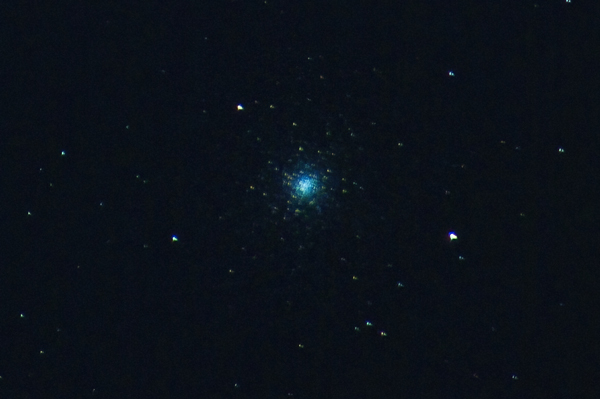Messier 3 is a globular cluster in the constellation Canes Venatici. It’s best viewed in spring.
By mid-June, Bootes, the herdsman, takes his place at the top of the sky. Nearby is the constellation Canes Venatici and its bright star Cor Caroli. Between the two constellations lies Messier 3. M3 is one of the finest globular clusters in the northern sky. An amazing 500,000 stars make up this cluster. If you look at an astrophoto of M3, you’ll see a beautiful array of yellow, white, and blue stars. What’s more, the cluster is known for a good number of blue stars and variable stars. While it’s actually possible to see the cluster with the naked eye from a dark site, a pair of binoculars or a telescope will allow you to see it from light-polluted skies.
My Observations
| Date | May 15, 2021 |
| Time | 10:35 p.m. |
| Location | Seattle, WA |
| Magnification | 102x |
| Scope | Meade 8″ SCT |
| Eyepiece | 20mm |
| Seeing | Average |
| Transparency | Average |

I’m really impressed with how bright M3 is in the scope tonight. The lack of a bright moon helps. My wife joined me for a few minutes to see M3, and we both agree it “floats” in the eyepiece. It’s almost as if someone lit a dim firework in the sky. Several brighter pinpoint stars are sprinkled like salt on the great fuzzy ball of the cluster. As I use averted vision, more individual stars pop out, which adds to the beauty and 3D-like effect of the object.
Date: June 25, 2020
Time: 11:07 p.m.
Location: Seattle, Washington
Scope: Meade 8″ ACF
Eyepiece: 18mm
Temp: 67F
Seeing: Average
Transparency: Average

The dark winter months of the Pacific Northwest continue to fade away while overcast days become less the norm. I’m glad for this. Tonight, the humidity is low and seeing is above average. As I look through the scope, I realize M3 lives up to its reputation as a fantastic object. The cluster is well defined and bright. It “floats” in my eyepiece on this quiet night.
Backyard Photo

Key Stats
| When to view | May-July | R.A. | 13h 43m 08.98s |
| Constellation | Canes Venatici | Declination | +28 16′ 22.8″ |
| Visual Magnitude | 6.3 | Distance | 31,000 ly |
| Absolute Magnitude | 18′ | Age | 11.4 billion |
| Apparent Size | 18′ | Milky Way Location | Sagittarius Arm |
| Diameter | 174 ly | Viewing Grade | A |
Historical Observations
May 3, 1763: Charles Messier
“Nebula discovered between Bootes & one of the Hunting Dogs of Hevelius [Canes Venatici], it doesn’t contain any star, its center is brilliant, & its light is gradually fading away, it is round; in a beautiful [dark] sky, one can see it in a telescope of 1-foot.”
Sources and Notes
- The photo of M3 on this page is by Adam Block/Mount Lemmon SkyCenter/University of Arizona and is licensed under a Creative Commons Attribution-ShareAlike 3.0 United States License.
- Charles Messier notes from the website: Messier.seds.org
- Sketch by Wayne McGraw
